California is home to thousands of caterpillar species. Some will become moths, others will become butterflies. Some will destroy plants and crops and others that are harmless. The caterpillars also range in color and size with different growth stages.
If you are trying to identify the caterpillar you just saw in your yard or when you were out walking, continue reading. While we cannot list all the caterpillars in California, we have listed the most common caterpillars you may encounter throughout the state.
Table of Contents
Are California Caterpillars Poisonous
Caterpillars with bristles, spikes, or a fuzzy appearance are typically poisonous and should not be handled.
For example, the woolly slug or puss caterpillar is a poisonous caterpillar (Fortunately, this caterpillar is not in California). It has hollow spines that are filled with poison. They feed on trees including the elm, sycamore, and elm. They vary in size, growing up to 3.6cm in length. While they are not that common in California, you may encounter one, known as the silver-spotted tiger moth caterpillar.
Symptoms associated with the puss caterpillar include intense pain, which is immediate, along with an itchy rash and swelling. You may experience a fever, nausea, vomiting, and muscle cramping.
If you think you have come into contact with a puss caterpillar, carefully remove the spines using tape and call your doctor.
Caterpillars in California
The common caterpillars in California include:
1. Monarch Caterpillar

The Monarch caterpillar (Danaus plexippus) becomes the beautiful monarch butterfly, belonging to the Nymphalidae family. It is one of the most common butterflies you will encounter in California and an important pollinator.
During the fall, these butterflies migrate to southern California. The caterpillar goes through five growth stages and molts at the end of each stage. The growth stages last up to five days, depending on the availability of food and the temperature.
When the caterpillar first hatches from the egg, it is a light gray/white or green. They are shiny with large black heads. The caterpillar eats the eggshell and then feeds on milkweeds, leaving an arc-shaped hole in the leaves. Over time they develop dark stripes on a green background with bumps just in front of the tentacles.
In the second growth stage, the caterpillar develops a black, white, and yellow banding pattern with a yellow triangle on the head and two yellow bands around the triangle. The banding becomes distinct in the third growth stage with longer tentacles. At this stage, they are around 1.5cm in length.
The banding pattern changes in the fourth growth stage, developing white spots near the back and by the fifth stage, they have a complex banding pattern. In the fifth stage, they can damage the leaf, causing it to fall. They are around 4.5cm at this stage.
They stop feeding and move away from the milkweeds to prepare for pupating.
2. Painted Lady Caterpillar

The Painted Lady (Vanessa cardui) is a strong flying butterfly found in open countryside and urban gardens. The caterpillars are commercially reared and it is one of the most commonly reared butterflies for children.
As butterflies, they have white on the tip of the forewings with an overall color of orange. Males and females look alike with a wing span of 8.5cm.
As caterpillars, they feed on mallow and nettle. The singly laid eggs are placed on the upper side of a leaf and take approximately ten days to hatch. The caterpillar hatches, living in a tent of leaves, which are spun together using silk.
You may see black speckles in woven leaves, which is a sign that the caterpillar may be present. As they grow they start to feed outside the tent, feeding on the plant. They remain in caterpillar form for around twenty-eight days before they pupate. A butterfly will emerge in approximately twenty-eight days.
3. Gray Buckeye Caterpillar
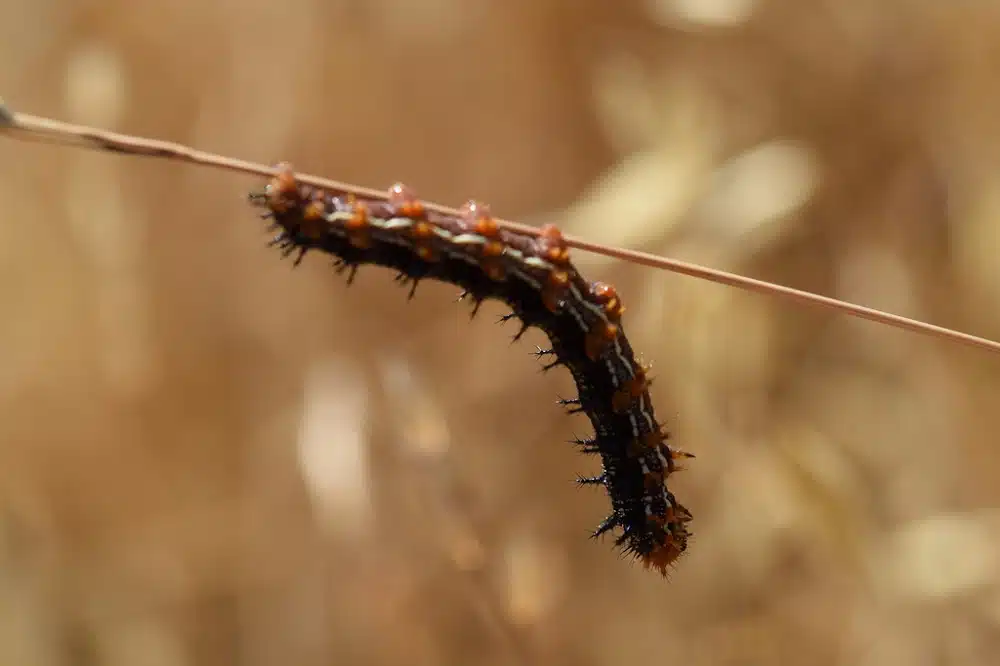
The Gray Buckeye (Junonia grisea) is a butterfly in the Nymphidae family. It is brown with eye spots on the wings. The caterpillar is black with white stripes and orange patches. It also has branched spines.
Caterpillars feed on American plantain, wild petunias, false foxgloves, and blue toadflax. They are commonly encountered in waste areas, open fields, roadsides, and trails.
4. Small White Caterpillar

The Small White Caterpillar (Pieris rapae) grows to become the cabbage white or cabbage butterfly. It is a white butterfly with small black dots on the wings. The caterpillar is known as the imported cabbage worm, a pest to crops including kale, bok choy, cabbage, and broccoli. It has only been introduced to North America in the past two centuries, due to accidental introductions.
The female butterfly lays eggs on cultivated and wild cabbage, laying a single egg on each plant. The eggs are yellow. The caterpillar is blue-green with black pints and a black ring around the spirals. There is a row of yellow dashes.
The caterpillars are often seen under the leaves of the host plant. The caterpillar has a black head during the first and second growth periods. They develop a green-yellow dot behind the eyes with a black head in the fourth and fifth growth stages.
This caterpillar is a serious pest for commercial cabbage farmers. The pupa is mottled-gray or yellow with a large head cone. Once the adult butterfly emerges it can fly up to twelve kilometers in one flight. Females fly around 0.7km each day, while males spend their day patrolling host plants looking for a willing female.
5. Variable Checkerspot Caterpillar
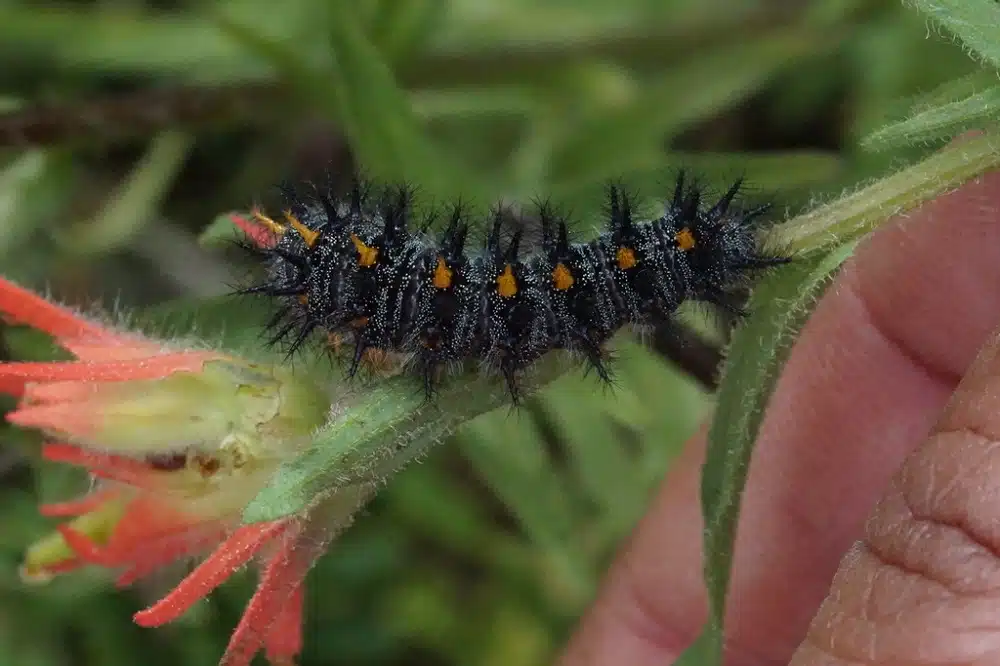
The Variable Checkerspot (Euphydryas chalcedona) is a butterfly belonging to the Nymphalidae family and commonly seen in California. This black or brown butterfly has yellow or white checkered markings with some red on the wings. Females search for a host plant close to nectar. The caterpillars feed and live on the host plant.
The female butterfly lays a cluster of eggs and the caterpillars, once hatched, move to fresh parts of the plant to find a better food source. The caterpillar moves away from the food source, finding a good hiding spot to hibernate. They are usually found under dead branches or dried weeds.
During hibernation, the caterpillars wake and feed and then return to their hiding space. The caterpillars can hibernate for years in high elevations. They begin to pupate in early April with adults flying from mid-April and May.
6. Gulf Fritillary Caterpillar

This beautiful bright orange butterfly (Dione vanillae) belongs to the Nymphalidae family and has long and narrow wings. They are commonly encountered in California. The caterpillar is striking in color. It is dark orange with black spines.
The caterpillar has five growth stages. Once the eggs hatch, the caterpillar eats the eggshell for nutrition and then moves to consume other eggs or part of the host plant. They consume the leaves of the host plant for the first three growth stages.
The caterpillar moves on to the leaf margins in the fourth and fifth growth stages. Depending on whether the food is plentiful or scarce determines if the caterpillar abandons a leaf and moves to another food supply.
7. White-lined Sphinx Caterpillar

The White-lined Sphinx Caterpillar (Hyles lineata) is a moth of the Sphingidae family. The moths are often referred to as hummingbird moths due to their flight pattern. The caterpillars range in color and have a wide geographical range.
As caterpillars, they are powerful feeders, known to form groups that are capable of damaging entire gardens or crops. The caterpillars are black with orange spots with a green or orange head and anal plate. They have a tail-like spine protruding from the back, giving them the name hornworm.
The horn can be black or yellow. It is not a stinger and these caterpillars are not harmful to humans.
8. Anise Swallowtail Caterpillar

This (Papilio zelicaon) is a common swallowtail butterfly with black wings with a wide yellow stripe. There are blue spots at the rear edge of the back wings.
The caterpillar can grow to 6cm in length with a green body and black banding. They also have orange dots, a black and yellow body, and black spikes. The antennae are orange and the head is green with black lines.
When they first hatch, the young caterpillar is predominantly back with white bands. A row of red spots forms along the back and sides. As they age, there are alternative rings of black and green with bright orange dots on each black band. The green coloration becomes prominent.
The caterpillar has an antennae-like appendage on the head which is a defensive organ, it emits a horrid odor that deters predators.
9. Western Tiger Swallowtail Caterpillar

This swallowtail butterfly (Papilio rutulus) is often seen in gardens and parks. The caterpillar feeds on popular trees, including ash trees and sycamores. They also feed on cottonwoods, alters, poplar, and willows.
Caterpillars resemble bird droppings in the first two growth stages. They change their appearance considerably in the third growth stage and by the fifth growth stage, they are smooth and green. They are often confused with a snake by predators.
10. Gray Hairstreak Caterpillar

The Gray Hairstreak (Strymon melinus) belongs to the Lycaenidae family and is the second-largest butterfly. The butterfly is gray with orange spots. Caterpillars are green with markings on the sides and short yellow hairs.
As caterpillars, they feed on fruits and plants of mallows, peas, buckwheat, and clover. The male butterfly spends his days on small trees looking for a receptive female. The female lays a single egg on the flower of the host plant. Once the caterpillar emerges, it feeds on the flowers and fruits.
The caterpillars are green, though the color varies based on the color of the host plant.
11. Mourning Cloak Caterpillar

The Mourning Cloak Caterpillar (Nymphalis antiopa) becomes a large butterfly. The caterpillars are often called the spiny elm caterpillar or white petticoat. The butterfly can live for up to twelve months, making it one of the longest lifespans for butterflies in the world.
The caterpillars have a striking appearance with black bodies and eight red-orange dots that run down the back. The legs are dark red. The body has short hair and black spines. A fully grown caterpillar can reach two inches in length.
12. California Sister Caterpillar
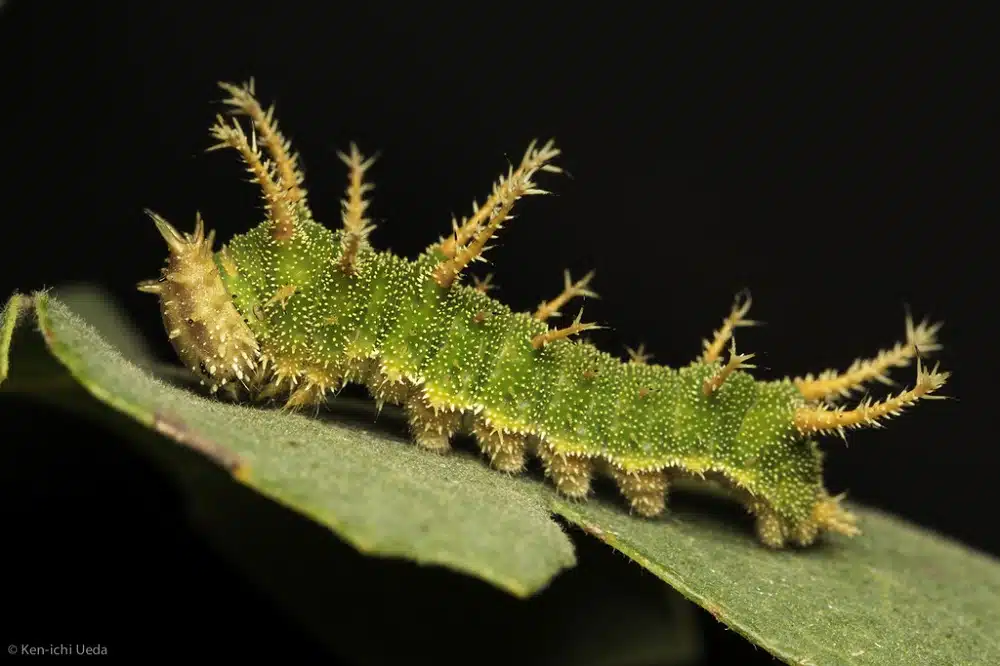
The California Sister Caterpillar (Adelpha californica) becomes a beautiful butterfly from the Nymphalidae family. They are very common throughout California, including northern Baja California. The wings are black to dark brown with cream-white bands and orange patches close to the tips of the forewing.
The caterpillars go through five growth stages. The caterpillar hatches from the egg and is olive green and has a dark brown head. It creates a perch from the leaf. It molts after nine days, entering the second growth stage.
It is green with brown shades and has a light brown head in the second growth stage, which lasts eight days. The third growth stage sees the caterpillar change to a brown-yellow with yellow conical spikes and a horn-like protrusion. In the fourth growth stage the caterpillar becomes red-brown with green sides and yellow tubercles, this stage lasts nine days.
In the fifth and final growth stage, the caterpillar becomes olive green with brown legs and underside. It is covered in yellow tubercles. Some segments have thick spines with black tips. The brown head is flattened and smooth.
13. Pipevine Swallowtail Caterpillar

The Pipevine Swallowtail Caterpillar (Battus philenor) becomes a swallowtail butterfly, common in California. The butterfly is black with iridescent blue hind wings. They are commonly encountered in forest areas.
The caterpillars are red or black and feed on the host plant. They take acids from the plants they feed on, which helps them defend themselves from predators. The caterpillars feed on pipevine plants, which include Virginia snakeroot, Woolly Dutchman’s pipe, Watson’s Dutchman’s pipe, and California Dutchman’s pipe.
14. Red Admiral Caterpillar

The Red Admiral (Vanessa atalanta) is a medium-sized butterfly. It has black wings, red banding, and white spots. The adult butterfly is seen in moist woodlands. The caterpillars’ primary host plant is stinging nettle and false nettle.
Caterpillars are around 2.5cm in length and vary in color. They are mostly black with white spines and spots. The pupal period and the coloration are determined by the local temperatures. In high temperatures the pupal period is six days, extending to fifty days in colder weather.
The pupae are bright scarlet when they are in high temperatures, but are black in lower temperatures.
15. Lorquin’s Admiral Caterpillar
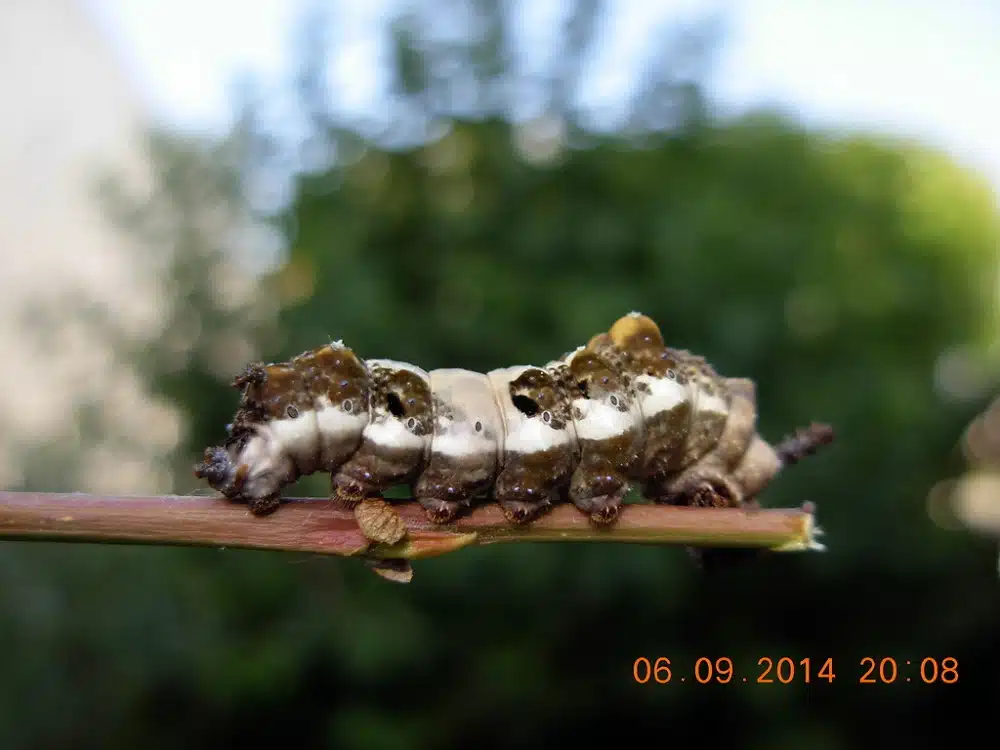
This caterpillar (Limenitis lorquini) becomes a butterfly from the Nymphalidae family. It has brown-black wings with white spots. The forewing has orange tips.
The caterpillar is yellow with a white patch on the back. The female butterfly lays her eggs on the tips of the leaves. The caterpillar feeds off the host plant, which includes poplar, cottonwood, cheery, plum, apple, and willows.
16. Mylitta Crescent Caterpillar
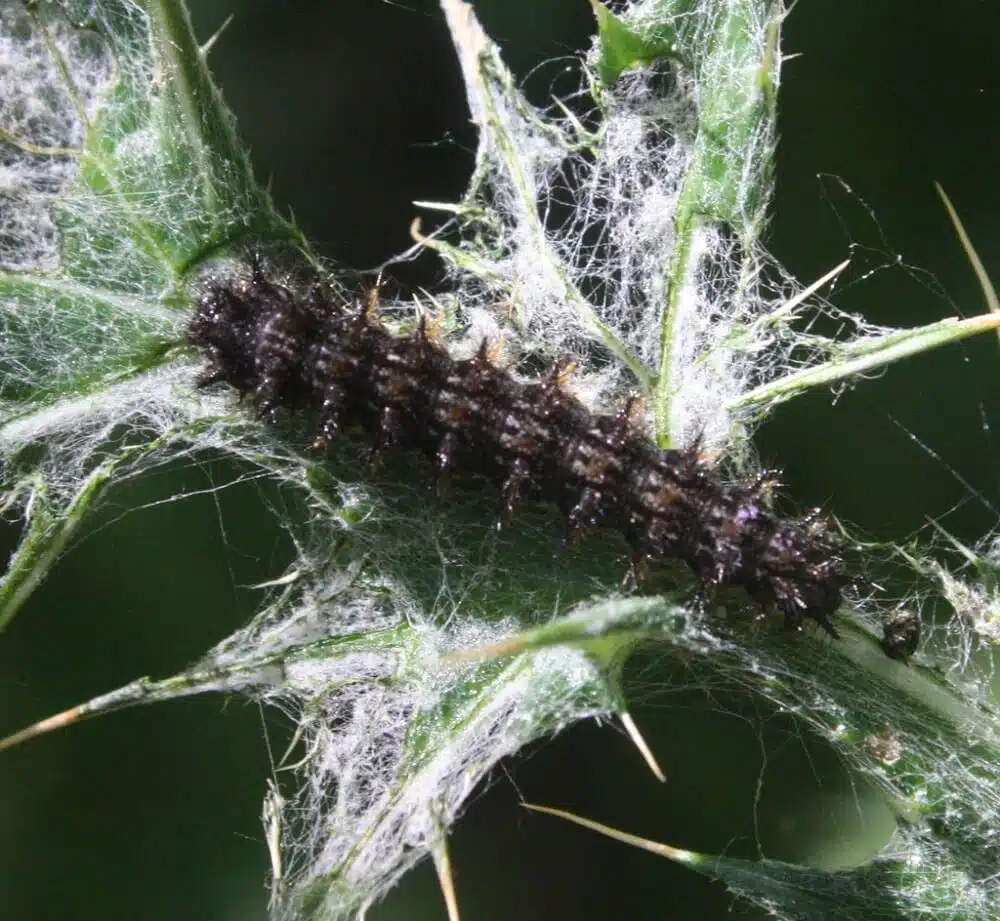
This butterfly (Phyciodes mylitta) is common in California. The butterfly, which belongs to the Nymphalidae family, can grow to 3.7cm in wing span. The wings are orange with black markings and white bridges. They are common until the fall in California.
The butterfly can be found in a range of habitats, usually in forested areas and meadows. The caterpillars are black with white markings. They have spines and feed on Cirsium and Carduus species.
The caterpillars’ spines are orange and will eat leaves until only a skeleton is left. They are sometimes found in silk nets if they have not pupated before winter. The caterpillars will hibernate and will sun themselves on sunny winter days.
The caterpillars preferred host plant is thistles, both invasive and native. They are excellent at combating invasive thistles.
17. West Coast Lady Caterpillar
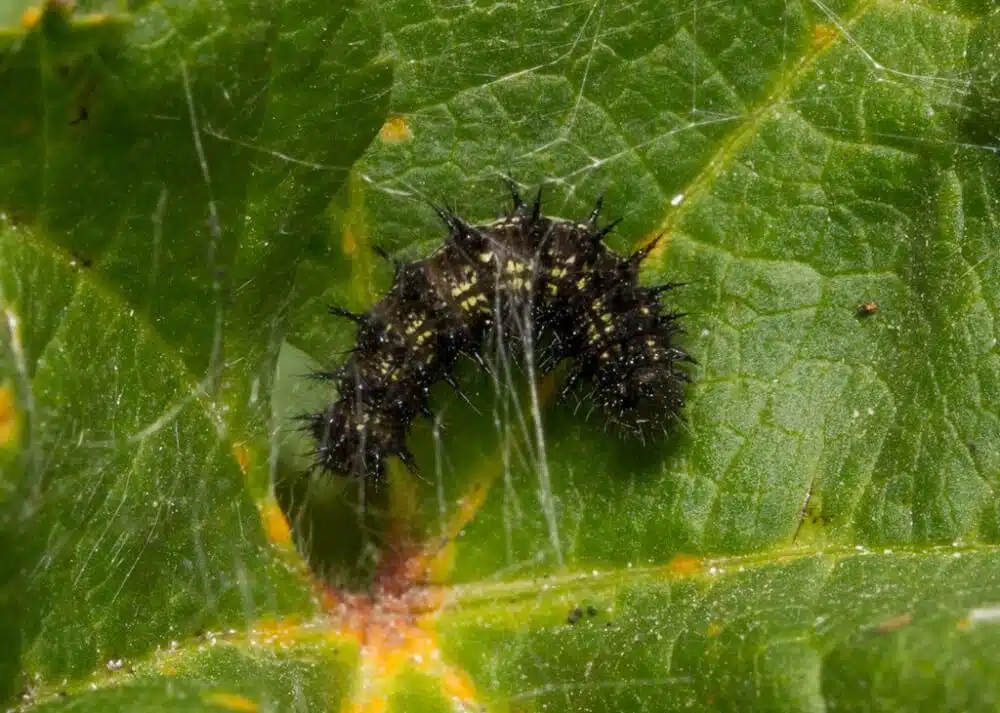
This (Vanessa annabella) is a brush-footed butterfly. The young caterpillars build nests made of silk in the center of a leaf. Sometimes the nest is made from multiple leaves silked together. The caterpillars feed mostly on mallow plants.
The caterpillar will take around four weeks to transform into a butterfly. The caterpillars vary in color, though the majority are black or mottled gray with two stripes. Pupae also vary in color and are often brown with a metallic sheen.
The female butterfly will lay a single egg on the upper side of the leaf of a host plant. When the caterpillar hatches, it lives in a silken nest and eats the leaves of the host plant.
18. Pale Swallowtail Caterpillar
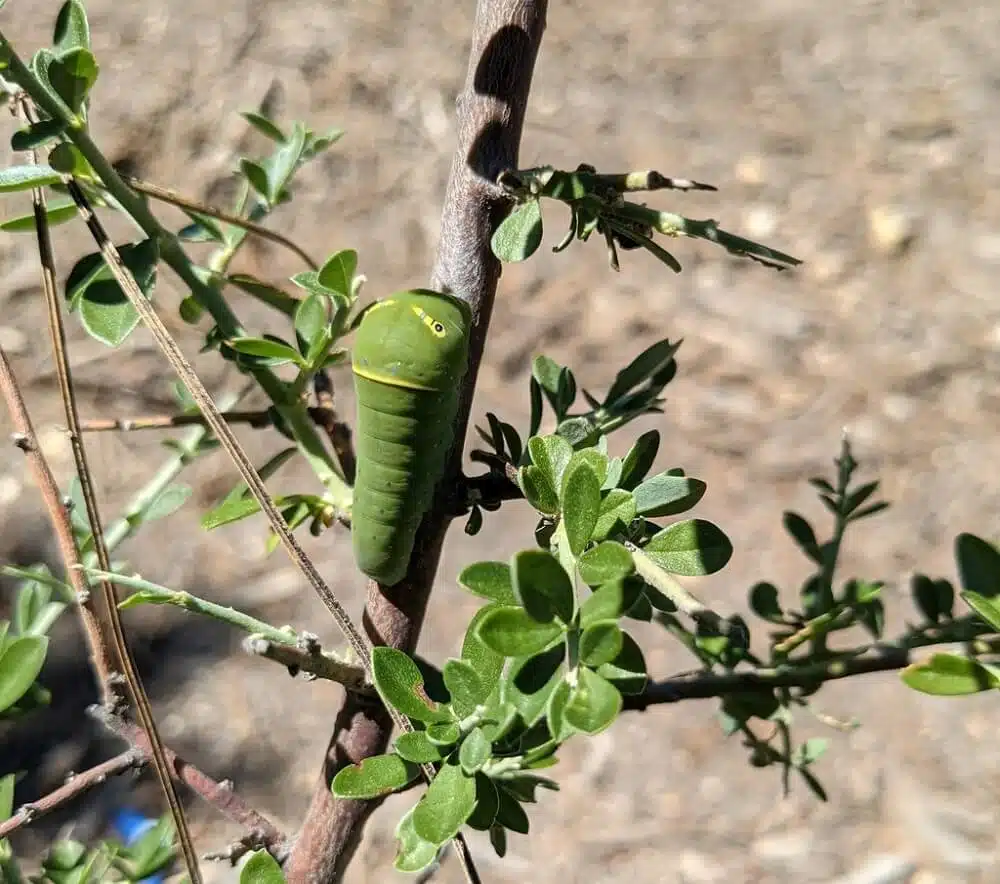
This (Papilio eurymedon) is a common butterfly found in California. The caterpillars enter a pupal stage in the fall and after winter, they emerge as a butterfly. A single egg is laid on a host plant leaf, which includes buck brush, mountain lilac, mountain balm, ocean spray, bitter cherry, and red alder.
The caterpillars are green and plump. It has a yellow band and two eye-shaped spots, which is used to deter predators.
19. Western Giant Swallowtail Caterpillar

The female butterfly (Papilio rumiko) lays a single egg on the young leaves and shoots off the host plant. The eggs are light yellow and change to an orange-brown just before they hatch. The caterpillar is around 5mm when it first hatches and is yellow-brown, looking similar to a bird dropping.
They grow to 11mm in the second growth stage and have brown heads. By the fifth growth stage, the caterpillar is 5cm in length. They lift their heads and inflate their bodies when threatened or startled, which reveals an eyespot.
The pupae are a plate gray that is a similar color to a tree branch. The coloration of the pup is determined by the branch color it is resting on.
20. California Tortoiseshell Caterpillar
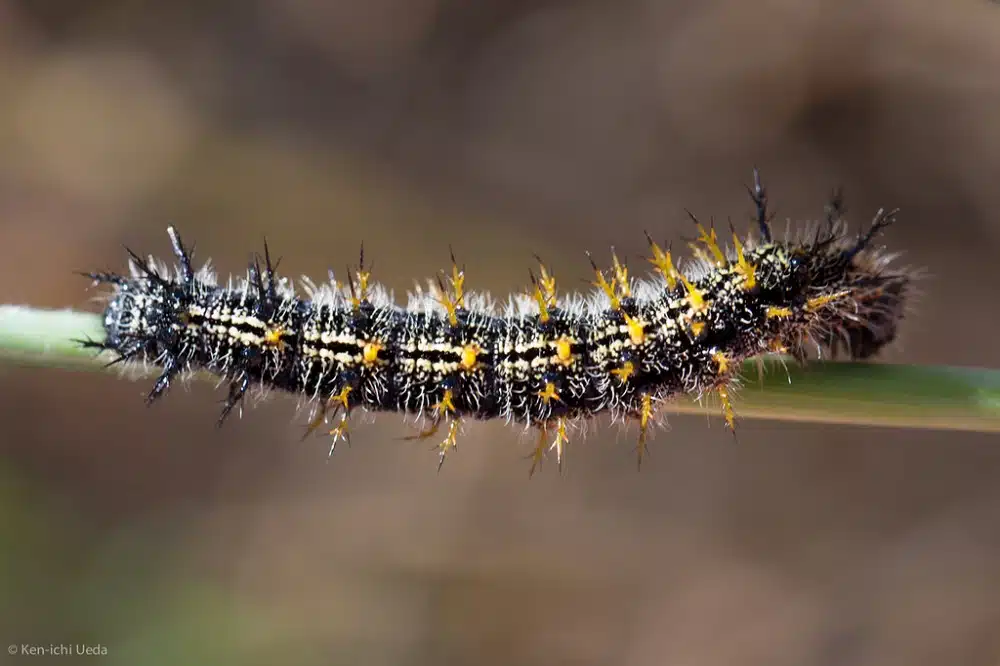
This butterfly (Nymphalis californica) belongs to the Nymphalidae family and has ragged wing edges. The wings are orange with black spots and a black margin. The caterpillar is black with white hair and spots.
There is seven spines on each body segment of the caterpillar. The butterfly has irregular population explosions and is prey to ravens.
21. Checkered White Caterpillar

This (Pontia protodice) is the southern or checkered white cabbage butterfly, that belongs to the Pieridae family. The green caterpillar is a cabbageworm and has black dots and a blue-green body with a yellow stripe.
They pupate over winter, which varies in color. The caterpillar is covered in fine hair but is not considered dangerous to humans.
22. Carolina Sphinx Caterpillar

The Carolina Sphinx Caterpillar (Manduca sexta) turns into a moth, known as the Caroline sphinx moth or tobacco hawk moth. The caterpillar is referred to as the Goliath worm or tobacco hornworm. The caterpillar feeds on the leaves and stems of the Solanaceae plant family.
The caterpillar is often confused with the similar tomato hornworm, but it has seven white lines with a black border and red horns, rather than the V-shaped markings and dark blue to black horns of the tomato hornworm.
The caterpillars are bright green and can grow to 7cm in length. They have a horn at the tip of their body. The body is covered in fine hair. The head has chewing mouthparts. They feed on plant foliage, ingesting pigmentation carotenoids, which are yellow.
These caterpillars feed on tobacco and tomatoes. At the end of the last growth stage, the caterpillar burrows underground to pupate. This is known as wandering. These caterpillars are prey to the parasitic braconid wasp, which lays its eggs in the caterpillar. The wasp larvae then feed on the internals of the caterpillar when they emerge.
If you see one of these caterpillars covered in white cocoons, then it has been invaded by the wasp larvae.
23. Salt Marsh Caterpillar

This caterpillar (Estigmene acrea) turns into the salt marsh moth or acrea moth, belonging to the Erebidae family. It was first described in 1773 and is common in California. The caterpillar can grow to 5cm in body length and varies in color.
These caterpillars can be rusty orange, dark brown, black, or pale yellow. You may see some orange or black warts on the body. There is also one small white dot on each body segment.
The caterpillar will pupate in a cocoon made from its hair, wrapped in a leaf or debris. They remain in the caterpillar stage throughout winter and pupate in spring. The adult moth emerges in the late spring.
24. Western Tussock Moth Caterpillar

This moth (Orgyia vetusta) is dimorphic and the females do not fly. The caterpillar is black with long bristles when they first hatch. As they mature, they have yellow and red spots. They can grow to 5cm in body length.
The mature caterpillar will pupate in a cocoon made of discarded hairs.
25. Silvery Blue Caterpillar
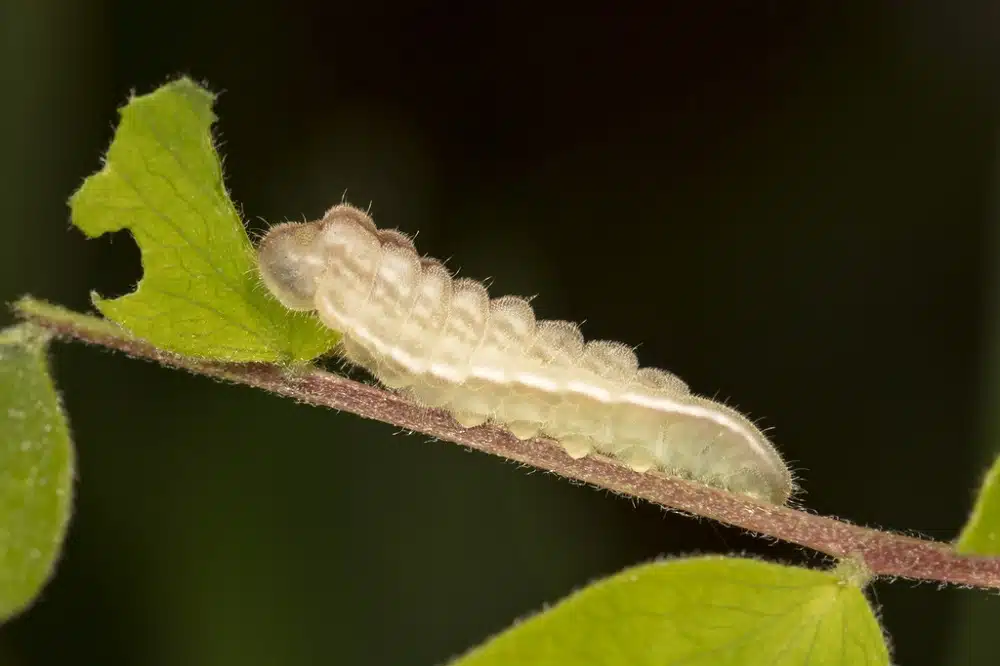
This (Glaucopsyche lygdamus) is the caterpillar of a native butterfly that is light blue. They are common in California with a wing span of 2.8cm. They are commonly seen in dunes, wooded areas, and alpine meadows.
The caterpillar is small and rugged. They are green with a maroon line that runs down the body. You often see these caterpillars with ants as they feed on the leaves of the host plant.
The pupa is light brown with dark brown streaks. They overwinter in the pupa form and emerge as a butterfly in spring or summer.
26. American Lady Caterpillar

The American Lady (Vanessa virginiensis) is a common butterfly. The caterpillars feed on cudweeds, pussytoes, and everlastings. The eggs are small and green, blending into the host plant.
The caterpillars make a nest in the host plant, using silk to sew leaves or seed fluff together. They rest in their nest when they are not feeding. You can see the nest in the morning dew, as it shines in the sunlight.
As the caterpillar grows and ages it makes a nest at the base of the plant using leaves. They are often seen on the ground just below the host plant. The caterpillar is sage green and burgundy. They curl into a ball when disturbed.
They are not easy to spot when they are on the ground or in the grass. They hang from a silk pad when they are ready to pupate. They hang in a J position.
27. Large Yellow Underwing Caterpillar

This moth (Noctua pronuba) belongs to the Noctuidae family and is highly migratory. The caterpillars are found in grasses and will eat anything in the garden, including weeds. They move in groups and can cause serious and considerable damage in a very short period.
This is an invasive moth and a crop pest. They are a new invasive species in California and the rest of the US and there is still ongoing research on the species and identifying the most effective management methods.
28. California Oakworm

This moth (Phryganidia californica) belongs to the Notodontidae family and was first described in 1864. The moth can grow to 3cm in wing span and are tan with prominent wing veins. They can have two to three generations each year in California.
The caterpillars feed on oak tree leaves, especially coast live oak. The young caterpillars feed between the veins on the lower leaf, leaving the upper leaf surface intact. It still causes the leaf to dry and turn brown.
As the caterpillar ages, it eats through the leaf blade, leaving only the leaf veins. Small pellets fall from the canopy as the caterpillars feed. They can defoliate an entire tree or group of trees when they cause an outbreak.
These black caterpillars have yellow stripes and can grow to 3cm in body length.
29. Tussock Moth Caterpillar

These caterpillars (Lophocampa maculata) are not poisonous, but they can cause discomfort in humans with sensitivities. The caterpillars are common from July to September when they feed on willow and poplar leaves. They get their names from the tufts of hair on the caterpillar.
The caterpillars are covered in dense hairs and are often referred to as woolly bear caterpillars. They can sting but are not considered a medical emergency. The black hairs at the head and rear are separated by tufts of yellow and red-orange hair bands.
Younger caterpillars are white or yellow with long white hairs. There are orange or black dots running down the back.
30. Ceanothus Silk Moth Caterpillar
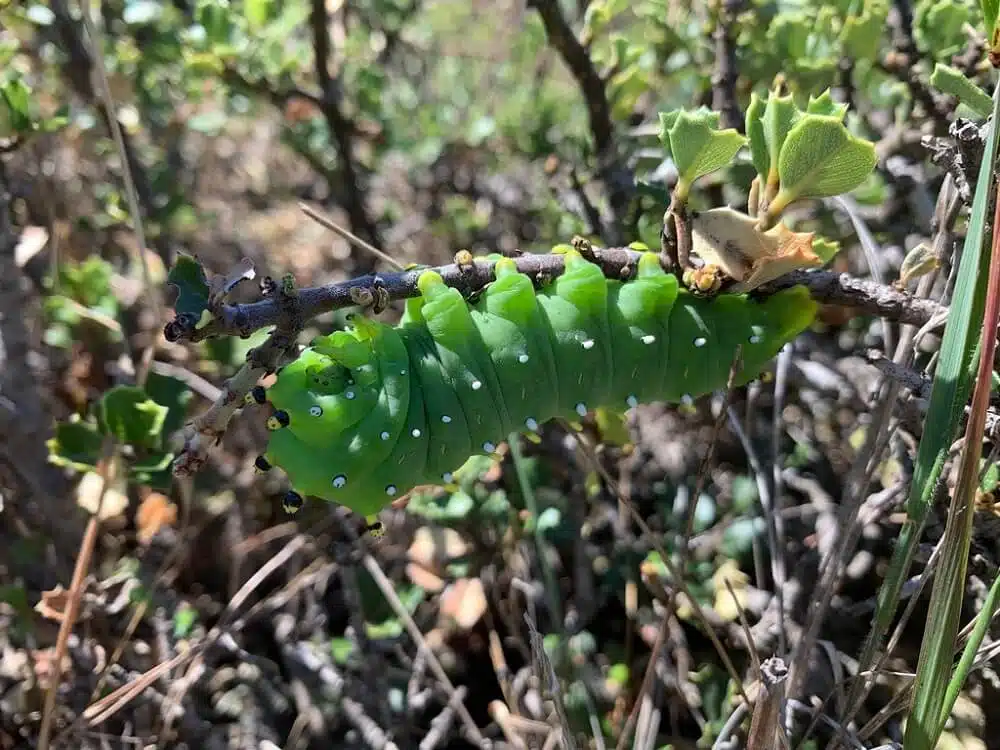
The Ceanothus Silk Moth Caterpillar (Hyalophora euryalus) will change color with each growth stage. By the third growth stage, they are brightly colored with yellow spines. By the last growth stage, they are green with white spines.
They spend the winter in a teardrop-shaped cocoon, which is attached to a leaf or twig on the outside of the host plant. The caterpillar eats the leaves from alder, cherry, gooseberry, birch, maple, and willow trees.
Due to their varied diet, they can be found in woodlands and coastal areas.
31. Cloudless Sulphur Caterpillar

This medium-sized butterfly (Phoebis sennae) belongs to the Pieridae family with angled wings and is small in size. The female lays a white egg, which changes to orange just before hatching.
The young caterpillar is green to yellow with side stripes and black dots on the back. They feed on partridge peas, clovers, and other legumes. The caterpillars grow to 4.5cm in body length.
When it’s time to pupate, they form a pointed pupa that is humped in the center. This can be yellow or green with green or pink stripes.
32. Sophora Worm

The Sophora Worm (Uresiphita reversalis) becomes a broom moth belonging to the Crambidae family. It was first described in 1864. A native to Mexico, it spread north and established itself in North America, including California.
The caterpillars feed on Acacia and Genista. They are brown-green with black heads. There are white dots present on the head. They overwinter in the pupal stage.
33. Edith’s Checkerspot Caterpillar
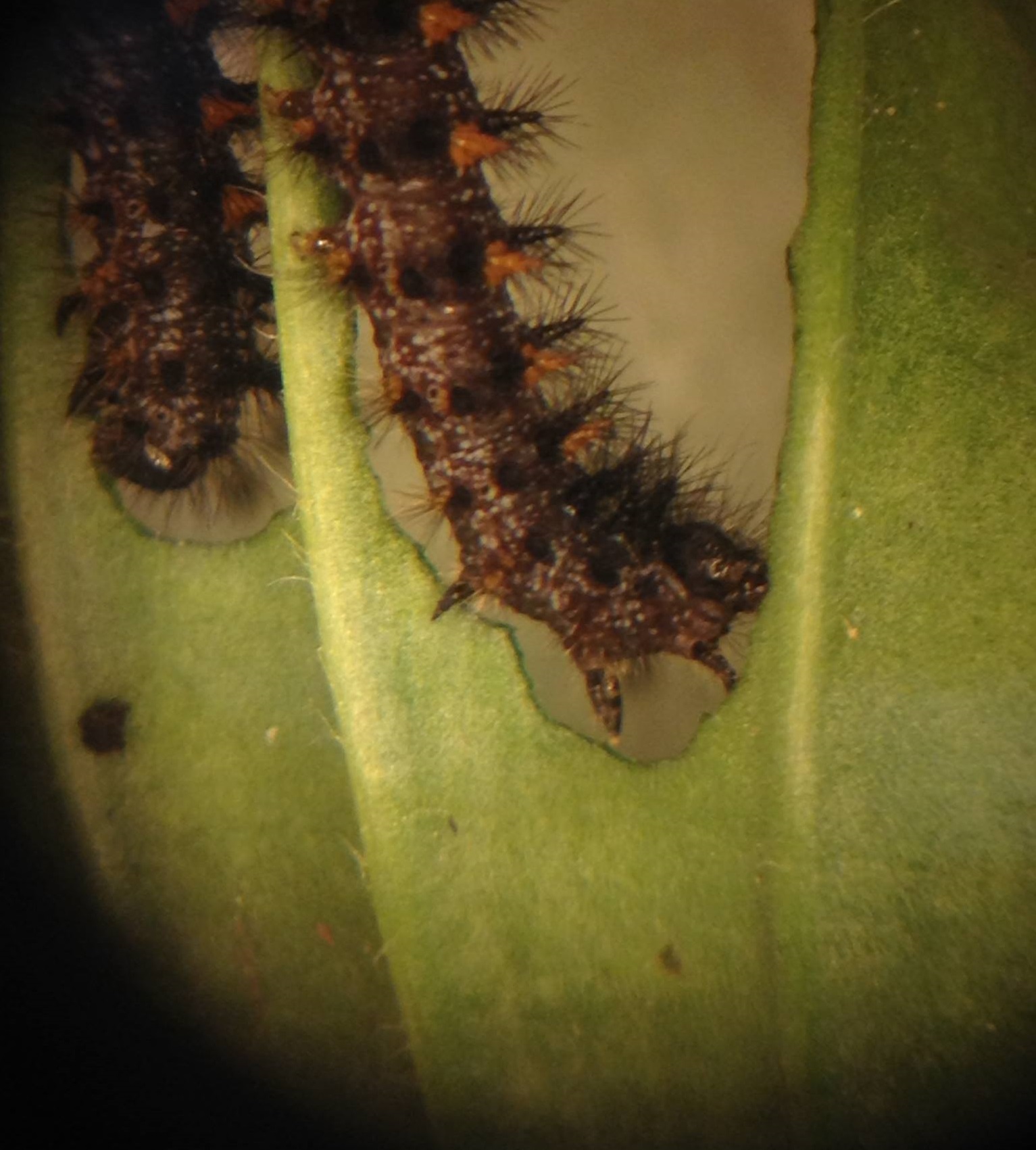
This butterfly (Euphydryas editha) belongs to the Nymphalidae family. The females mate once, while the males exhibit polygamy. Some subspecies have been threatened by habitat destruction and climate change. They are currently protected by the Endangered Species Act.
The caterpillar hatches from the egg and focuses on reaching full size before the host plants are scarce. Females enhance the survival of the offspring by laying egg masses on moist slopes where the host plant is most delayed.
The caterpillars are often seen soaking in the sun, regulating their body temperature. They grow faster at thirty-five degrees Celsius. The caterpillars feed on dwarf plantain, purple owl’s clover, and Indian paintbrush.
34. Queen Caterpillar

This large butterfly (Danaus gilippus) belongs to the Nymphalidae family and can grow to 8.5cm in wing span. This orange or brown butterfly has black wing borders.
The female butterfly lays a single white egg on the host plant, which is a member of the milkweed family. A black caterpillar emerges from the egg with white stripes and yellow spots. The caterpillar feeds on the host plant, taking chemicals from the plant that makes it distasteful to any predators. The caterpillar goes through six growth stages before it pupates.
The eggs are laid on flower buds, leaves, and stems of the host plant and are cone-shaped. The caterpillars darken as they age. The stripes can vary from one individual to the next with some caterpillars being observed with white, yellow, blue, or green stripes. They do not have hair or spines on the body.
35. Silver-spotted Tiger Moth Caterpillar

It (Lophocampa argentata) is important to note that this caterpillar has stinging hairs. It is known as the woolly caterpillar or woolly slug, as mentioned at the top of this article, under poisonous caterpillars. The stinging hairs contain venom, which causes a rash and burning in humans with sensitivities. You can admire the caterpillar, but do not touch it.
The caterpillars are gregarious and stay grouped in colonies on a single branch until they completely defoliate it. This is a black caterpillar with dense brown hair.
36. Cabbage Looper Moth Caterpillar

The Cabbage Looper Moth Caterpillar (Trichoplusia ni) is a pest for cabbage, Brussel sprouts, broccoli, and cauliflower. They are gray-mottled moths with a white or silver Y marking on the forewings. The caterpillars are green with a thin white line on the back and sides. They do not have hair and are completely smooth.
The caterpillar crawls in a looping motion and is present throughout the growing season. They are also known to feed on tomatoes, potatoes, beets, lettuce, spinach, and parsley. These caterpillars can defoliate an entire plant, feeding throughout the growing season. They feed on the underside of the developing leaves.
They spend the winter in a cocoon amongst the plant debris with moths emerging in spring. The eggs are pale yellow and hatch within ten days. Caterpillars feed for up to four weeks before they pupate.
37. Painted Tiger Moth Caterpillar
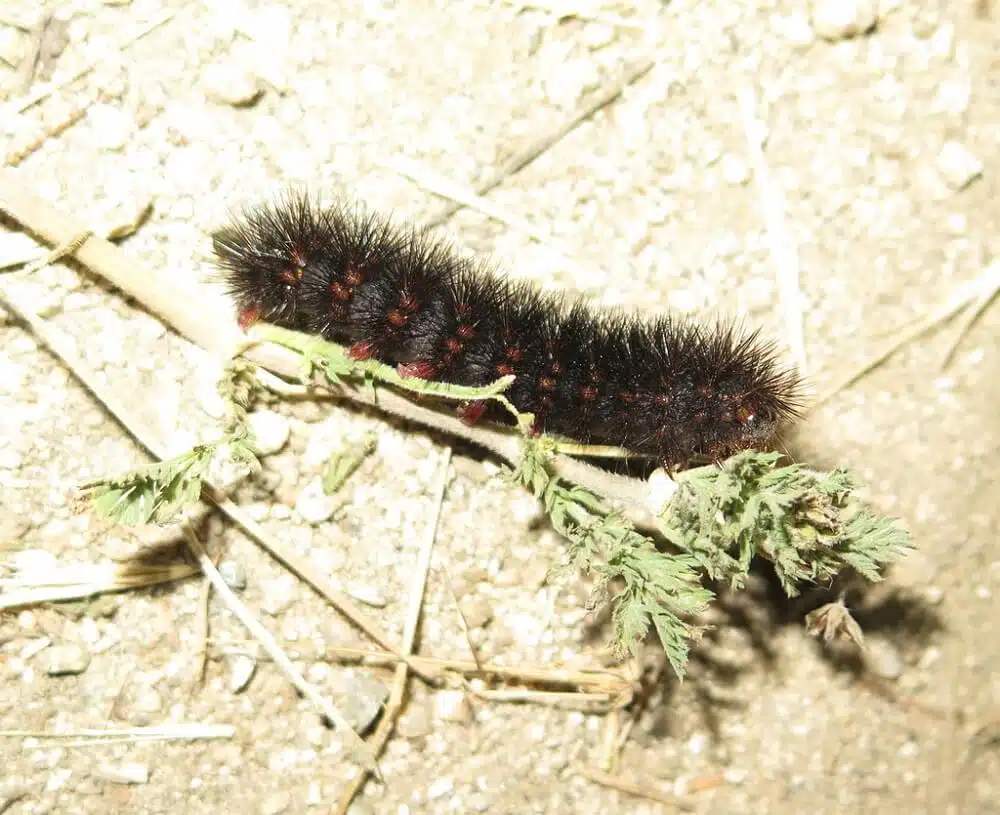
The Painted Tiger Moth Caterpillar (Arachnis picta) is not venomous, but it does have stinging hairs which can cause irritation in sensitive humans. The caterpillars feed on herbaceous plants.
The female moth lays oblong-shaped shiny eggs. The caterpillars hatch in spring and eat the foliage of low-growing plants. The caterpillars are black with rusty orange and tufts of bristles.
The caterpillars are active at night when their natural coloring provides camouflage. The adult moth emerges in summer and is active until the fall.
38. Satyr Comma Caterpillar
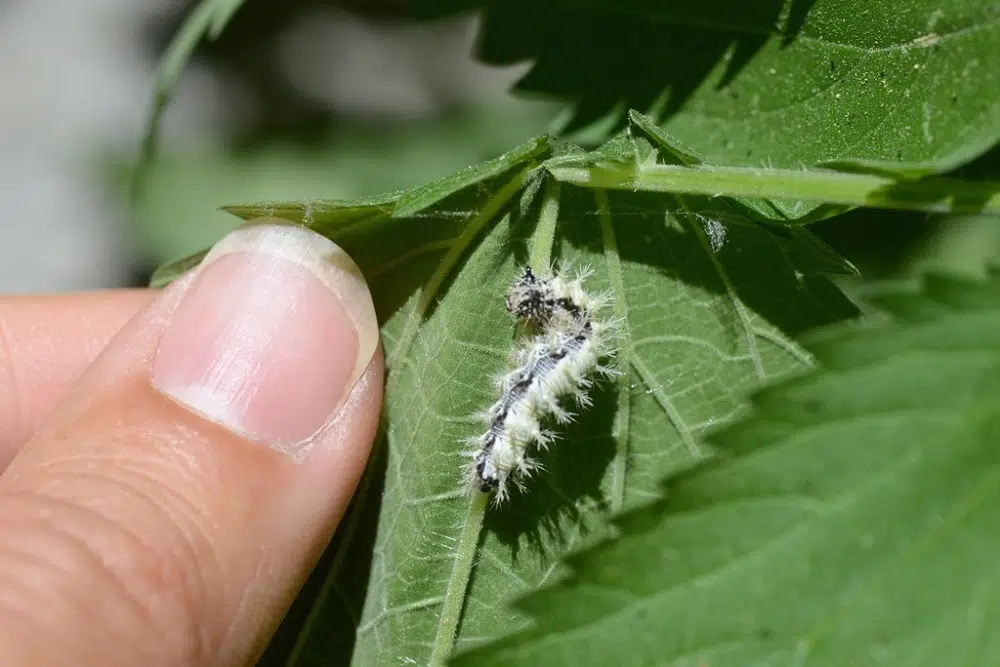
This North American butterfly (Polygonia satyrus) belongs to the Nymphalidae family and is similar to the Eastern Comma butterfly. The caterpillar feeds on stinging nettles. They are brown or black with a large white mark on the back. They have branched spines.
39. Banded Woolly Bear

The Banded Woolly Bear (Pyrrharctia isabella) is the caterpillar of the Isabella tiger moth. It was first named in 1797. This moth is common in colder regions with the caterpillar emerging in the fall and overwintering in the caterpillar form.
This caterpillar may look dangerous, but it does not have venomous hairs. The hairs can cause irritation in those with sensitivities.
There is a lot of folklore about the banded woolly bear, as when seen in large amounts it is believed to indicate how severe the coming winter will be. If the brown band is wide on the caterpillar, then it is meant to be a mild winter, but a narrow band shows a severe winter.
Some believe it is not the banding of the banded woolly bear that predicts the upcoming winter, but the direction the caterpillar is crawling in. If it is crawling south, it is escaping a cold winter.
40. Variegated Cutworm

The Variegated Cutworm (Peridroma saucia) is a moth, belonging to the Noctuidae family and was first described in 1808. It is seen on a variety of plants, including common vegetables and fruits.
There can be up to four generations each year. The development slows in colder temperatures. They are prone to numerous fly and wasp parasites, resulting in a large number of caterpillar deaths each year.
The variegated cutworm is a serious garden pest. They can cause considerable damage to fruits and vegetables, destroying crops each year. The egg is flattened at the end and is attached to a plant stem or leaf. They are laid in groups and will take approximately six days before a caterpillar emerges.
The caterpillar goes through six growth stages. The caterpillar is gray to brown with yellow or white spots. There is a black W-shaped marking on the eighth abdominal segment during the sixth growth stage. They have an orange to brown colored head.
The pupal stage lasts thirty-three days in cooler temperatures and around thirteen days in warmer areas. The caterpillars dig a hole in the soil and pupate near the surface.
41. Western Sheep Moth Caterpillar

This moth (Hemileuca eglanterina) belongs to the Saturniidae family and is a silk moth. It is often seen in the mountains in southern California. The moth appears in the summer months and feeds on Rosa, Rhamnus, and Ceanothus. They are often found in sagebrush areas.
The caterpillars are black with branched yellow spines that change to orange as they age. They have an orange-brown head. The moths are large, growing to 8.5cm in wing span with slender bodies.
42. Southwestern Eyed Sphinx Caterpillar
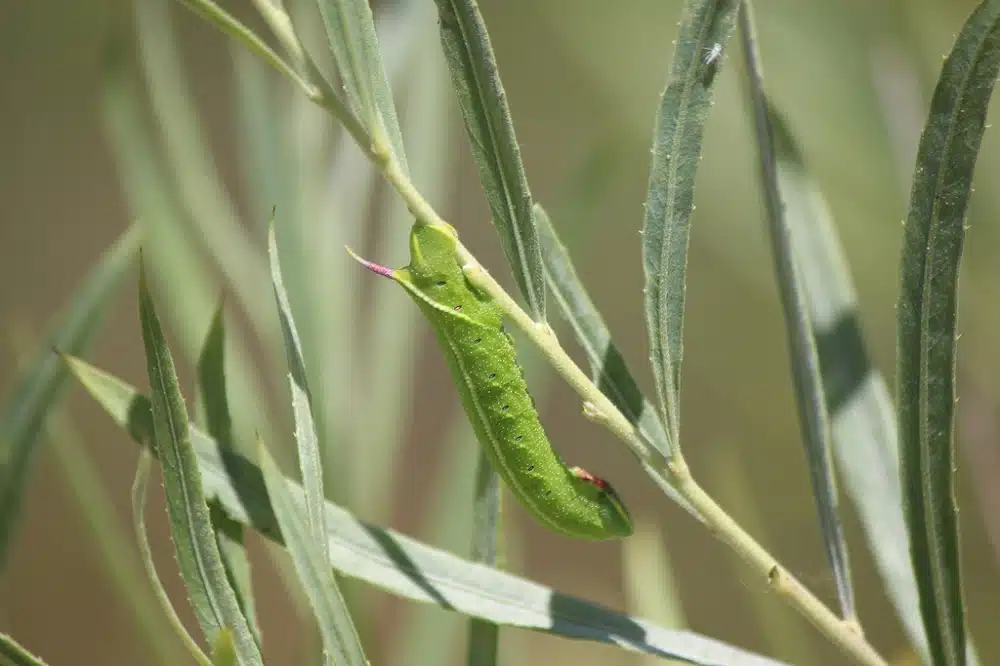
The Southwestern Eyed Sphinx Caterpillar (Smerinthus ophthalmica) is green with yellow lines and stripes. It has a short horn. They are common in forest areas and riparian habitats. They are also found in urban areas, coastal rainforests, and hardwood forests.
The caterpillars feed on willow and poplars, feeding on the leaves of the host plant.